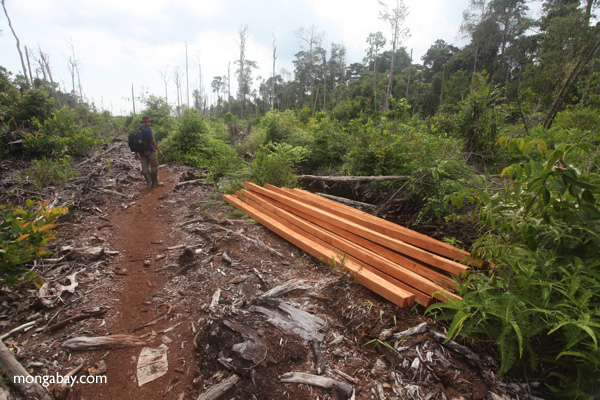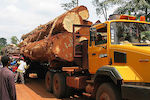
Illegally logged rainforest tree in Gunung Palung National Park, West Kalimantan, Indonesia. Photo by Rhett A. Butler.
Amid government schemes to curb illegal land clearing and systematically enhance a struggling legal wood certification system, a new report analyzing Indonesia’s forestry industry alleges that more than roughly 30 percent of wood used by the country’s industrial forest sector is derived from illegal sources. But some say the report’s analysis wasn’t deep enough to support its claims.
The report, released by Washington, DC-based NGO Forest Trends and The Anti Forest-Mafia Coalition, an umbrella group for Indonesian civil society actors, compares data from Indonesia’s Ministry of Forestry (which has since been merged with the Ministry of Environment) and the country’s thriving timber industry. It claims that raw materials processed by Indonesia’s pulp and paper mills surpassed the legal wood supply by 20 million cubic meters — enough to fill 1.5 million logging trucks.
“[Illegal timber likely] stems from the unreported clear-cutting of natural forests and other illegal sources instead of legal tree plantations and well-managed logging concessions,” Forest Trends said in a press release about the report, adding that Indonesia’s forestry plantations are currently both unsustainable and underperforming.

Illegally logged wood in West Kalimantan, Indonesia. Photo by Rhett A. Butler.
Indonesia currently has the world’s highest annual deforestation rate. The country lost 840,000 hectares of forest in 2012, overtaking Brazil.
Although the main source of Indonesia’s illicit wood is not definitively known, data published by the Ministry of Forestry points to a likely culprit: “conversion timber.” In 2013, the ministry reported that 53 percent of the timber obtained from natural forests was derived from “conversion timber” felled to make way for oil palm and pulp plantations. That’s 4,000 percent more than the figure the ministry forecast in 2007.
Greenpeace also weighed in via a statement. While the organization acknowledged it hasn’t yet gone over the report in detail, it recognizes the “major gap between legal timber production and consumption by the timber and pulp sectors,” and blames the lack of transparency in the timber industry.
“One of the problems facing assessments of supply and demand balances in Indonesia is the secrecy around company-specific supply data,” Greenpeace said in its statement.
The report also alleges that if Indonesia’s current mills were to operate at full capacity, and firms followed through with future construction plans, the industry would have to double its legal wood supply to meet demand. Otherwise, the legal supply gap could reach 59 percent.
“The timber industry’s own numbers show that Indonesia’s wood supply is unsustainable,” Forest Trends President Michael Jenkins said in the statement.
Forestry corporations operating in Indonesia are also attempting to fulfill plans to
increase their production capacities. Asia Pulp & Paper (APP), one of the world’s largest pulp and paper companies, for example, has made known its intention to construct new pulp mills in Sumatra. A $2.6-billion pulp mill in
South Sumatra — Indonesia’s biggest — is slated for completion in 2016. It’s
expected to churn out two million metric tons of pulp and 500,000 metric tons of tissue annually.

The central region of Sumatra is rife with concessions, particularly Riau. Data from Global Forest Watch Commodities show around 216,000 hectares of primary forest and 183,950 hectares of peatland forest were lost in Riau in 2012 alone, while logging concessions take up a relatively small portion of the province. Map courtesy of Global Forest Watch. Click to enlarge.
Despite a pledge by APP to halt deforestation of high-carbon stocks (HCS) and high conservation value (HCV) forests and peatlands, the report maintains that Indonesia’s processing capacity already exceeds the legal wood supply as it is, and thus such goals could not possibly apply to the industry as a whole. In fact, the Ministry of Forestry predicted in 2007 that the country’s plantations would be producing at almost twice the rate reportedly achieved today.
“If all companies implemented environmental commitments, such as ‘zero deforestation’ pledges, it would be impossible to meet current demand for timber,” Jenkins said. “Instead of allowing for new mills to be built, it would be advisable for Indonesia to hold future expansion of the pulp and paper industry until they successfully increase the number of tree plantations.”
However, APP maintains not all its wood fiber comes from Indonesian forests.
“In line with common global practice, APP’s fiber needs are not met solely by domestic wood supply,” Aida Greenbury, Managing Director of Sustainability at APP, told mongabay.com. “Fiber used comes from companies’ own concessions (if any), additional domestic suppliers, wood chips and pulp from the global market, as well as recycled content from domestic and global markets.”
Greenomics-Indonesia also questions the report’s assertions, saying its analysis was not thorough enough to substantiate its claims.
“The report still needs a much deeper assessment to conclude that more than 30% of Indonesian timber consumed by Indonesian forestry industry was illegal,” Elfian Effendi, Executive Director of Greenomics-Indonesia, told mongabay.com. “A supply-chain level analysis is really required to figure out how a certain forestry industry like pulp and paper sector sourced natural and plantation fiber for their operations. The supply-chain analysis also requires a strong spatial assessment to be carried out at a concession or supplier level.
“Unfortunately, the report has not yet come up with that kind of level. In my view, it is reasonable to say that the conclusion of the report is still premature.”
In addition to the ecological implications, the report asserts Indonesia’s rampant illegal logging has dire financial consequences. With such a large portion of the country’s industrial timber supply obtained illegally, it claims the government is losing out on billions of potential tax revenues. It also implies that the country can’t ensure that its Timber Legality Assurance System (SVLK) is not putting illicit timber on the market, a potentially painful blow to a recent Voluntary Partnership Agreement (VPA) Indonesia entered with the European Union.
The report states that Indonesia’s forestry exports are reportedly worth more than $10 billion a year as of 2013.
“Ultimately, Indonesia’s forest sector cannot remain viable and attractive to investment if it cannot operate within the law — a risk foreign investors are already starting to realize,” Jenkins said. “Due diligence will be crucial to ensure that the VPA does not provide a veneer of legality on new shipments of what is otherwise illegal wood.”
Citations:
Greenpeace, University of Maryland, World Resources Institute and Transparent World. 2014. Intact Forest Landscapes: update and degradation from 2000-2013. Accessed through Global Forest Watch on [date]. www.globalforestwatch.org
Margono, B. Primary forest cover loss in Indonesia over 2000–2012. Nature Climate Change,doi:10.1038/nclimate2277. Retrieved June 30, 2014, from Nature
“Logging.” World Resources Institute. Accessed through Global Forest Watch on Feb. 19, 2015. www.globalforestwatch.org.
“Oil Palm.” World Resources Institute. Accessed through Global Forest Watch on Feb. 19, 2015. www.globalforestwatch.org.
“Wood Fiber.” World Resources Institute. Accessed through Global Forest Watch on Feb. 19, 2015. www.globalforestwatch.org.
}}
Related articles
|
Brazilian indigenous populations grow quickly after first contact devastation (02/18/2015) Indigenous communities in South America have long experienced devastating impacts from contact with Western society. In the Sixteenth Century, European colonists brought slavery, war, and violence, but disease proved the most devastating. In all, European contact destroyed over 95 percent of the native population. |
|
Illegal logging still a big issue in Cameroon (02/13/2015) Cameroon is struggling to make progress in combatting illegal logging. Regulatory budgets are too thin to protect the country’s vast tracts of Congolian Rainforest. And demand domestically and abroad make the financial incentives for both the informal sector and Cameroon’s leaders too difficult to pass up, leading to an illicit timber trade beset with corruption. |
|
Illegal logging contributed to deadly Malaysian floods, according to government minister (02/11/2015) Heavy rains hit peninsular Malaysia in December, leading to severe floods that resulted in at least 21 deaths and the displacement of some 200,000 residents in the states of Kelantan, Pahang, Perak, and Terengganu. Now a minister with the federal government says he has proof that the flooding was caused in part by illegal deforestation. |
|
Sumatran community takes charge to protect its forest, attracts REDD+ attention (01/29/2015) Television inspired Syafrizal to act. As he watched report after report of land conflicts exploding in Sumatra and Kalimantan, he realized nobody was safe, and his village might be next. |
|
Rogue cop missing from jail (01/27/2015) An Indonesian police official busted for illegal logging in West Papua has been missing from jail for nearly a year after being granted permission to seek medication treatment, reports the The Jakarta Post. |
|
155 Chinese nationals arrested for illegal logging in Myanmar (01/27/2015) 155 Chinese citizens have been arrested in Myanmar for illegal logging, reports Agence France-Presse. |


